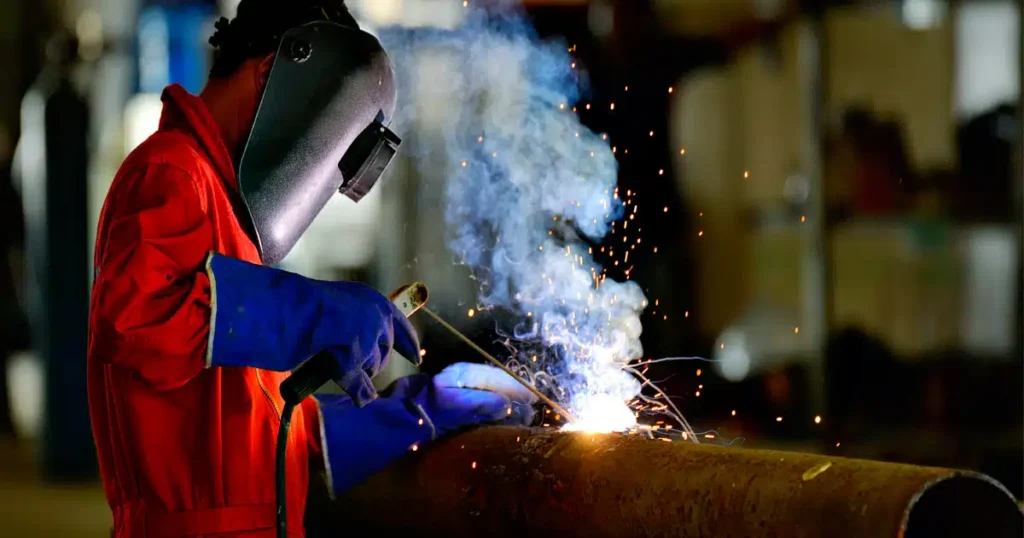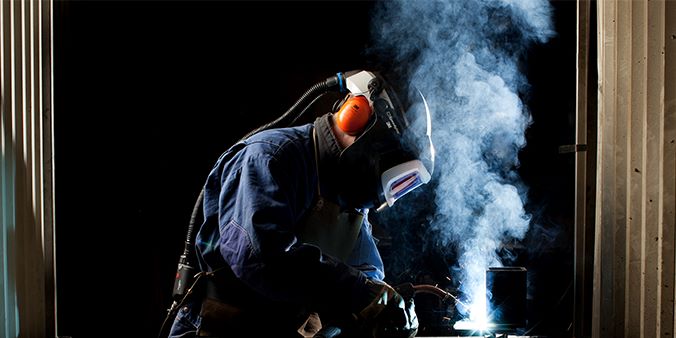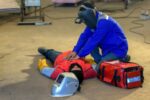Many welders are subjected to loud noises, tremendous heat, blinding light, and potentially toxic welding gases as part of their daily work.
Loud noise destroys the nerve endings in our inner ear, more exposure means more dead nerve endings. As a result, there is permanent hearing loss that cannot be restored surgically or medically.
Noise-induced hearing loss decreases your capacity to hear high-frequency noises and interpret speech, limiting your ability to communicate significantly. Hearing aids can help, but they cannot really restore natural hearing.
Welders are at a high risk of hearing loss due to their occupation. Welding is not a particularly noisy activity, but there are a few things that might impair hearing and hasten hearing loss.
Welding injuries to the ears are the most prevalent. Here are a few ear injuries you can encounter while welding:
- Injury in the ear canal- Airborne particles or objects that can pierce, cut, or puncture the ear canals.
- Hearing loss- Extremely loud and excessive noise that is either high-pitched or lasts for an extended period of time throughout an eight-hour shift. This might cause partial or total hearing loss.
Reasons for ear problems while welding
There are two reasons why hearing loss is common among welders:
- Drop-Weld Ear Injury
- Overexposure to fumes
Let us understand them in details-
1.) Drop weld injury– Workers in the steel industry and welders who are frequently exposed to flying sparks and molten metal slag are prone to drop weld ear injury.
A hole is frequently burned into the eardrum. There have been reports of the metal cooling in the middle ear and hardening around the ossicles. In such circumstances, surgery is required to remove the metal and restore the middle ear.
2.) Overexposure to fumes- Most individuals are aware that fumes can harm the respiratory system over time, but many do not consider how they may affect other bodily systems.
Evidence shows that inhaling these gases for an extended period of time can affect brain nerve cells as well as other bodily organs. This disturbance can also be connected to hearing loss.
These gases might have a range of effects on the welder over time. These include causing hearing loss, and also Parkinson’s disease, which have been related to Manganese exposure as one of the gases generated in welding fumes is manganese.
A welder may inhale fumes while doing a task, which may subsequently enter the lungs, circulation, brain nerve cells, spinal cord, and other organs, resulting in both immediate and long-term consequences.
How can you avoid ear injury while welding?
According to OSHA’s noise regulation, 29 CFR 1910.95, hearing protection is required when an employee’s noise exposure exceeds an 8-hour time-weighted average sound level of 90 dBA.
Here are a few things you can do:
1.) Protect your ears and neck by wearing a full-face welder’s helmet and a welder’s cap. It is critical to monitor noise threats and offer hearing protection as necessary.
2.) To muffle loud, harsh noises at work, try using earplugs or earmuffs. While welding, use fire-resistant foam or silicone custom-molded earplugs or ear muffs. Because grinding frequently precedes welding, you may also want them for noise reduction.
3.) Ear muffs are a flexible alternative for out-of-position or overhead welding jobs, because ear muffs shield the ear, sparks or splatter are prevented from entering the ear canal.
4.) The more pleasant the ear plug, like other kinds of PPE, the longer employees will use them. While purchasing ear plugs, search for new versions made of innovative materials that provide the best degree of comfort and noise reduction.
5.) Other possible solutions include isolating the noise through the use of distance, barriers, welding bays, and sound absorbing materials, as well as adopting regulations that restrict the amount of noise individuals are exposed to and the length of time they are exposed to it.
6.) Avoid spending extended periods of time in areas where there are overly loud or long-lasting noises.
7.) Get regular hearing exams to verify your hearing is in good working order.
8.) In addition to the noise produced by the numerous tools employed at your workplace, you must be mindful of the unexpected, brief, and extremely loud noises that occur on a daily basis like metal on metal, hammers slamming metal into place, and other abrupt loud spikes can exceed the 85 decibel limit, and are thus likely to harm your hearing if your hearing protection is not worn at all times.
Apart from ear injury, there are a few other injuries that can happen while you’re welding. Let us see what those are.
According to OSHA-
Each year, the Centers for Disease Control and Prevention (CDC) estimates that 22 million workers are exposed to potentially harmful noise at work.
Noise may be an issue in your employment if:
- When you leave work, you may notice ringing or humming in your ears.
- You have to yell to be heard by a coworker who was only an arm’s length away.
- When leaving work, you may have temporary hearing loss.
OSHA requires businesses to implement a hearing conservation program when noise levels are at or above 85 decibels aggregated over 8 working hours.
What is a hearing conservation program?
It is a program that aims to:
- Avoid initial occupational hearing loss
- Retain and protect residual hearing
- Provide employees with the knowledge and hearing protection equipment they need to be safe.
The employer is required by OSHA’s Noise Standard to reduce noise exposure through engineering controls, administrative controls, or Hearing Protection Devices (HPDs) to attenuate occupational noise received by the employee’s ears to levels specified in Table G-16 and Table G-16A of 29 CFR 1910.95(b) (1).
You may view table 16A here- https://www.osha.gov/laws-regs/regulations/standardnumber/1910/1910.95AppA
What are other injuries you may encounter while welding?
Consider some of the most common welding hazards that welders may encounter:
1.) Electrocution- Electrical shock to the welder’s face is a regular accident in the construction business. When any portion of the welding equipment is grounded, the damage is frequently caused by two metal pieces arcing electricity between them, resulting in a secondary voltage shock.
2.) Respiratory- Issues in the lungs. Chemical vapors created during soldering contain solid particles that can accumulate in the lungs. The composition of the particles changes depending on the metals utilized. Over time, these vapors can cause a variety of health concerns, including nervous system illnesses, cancer, renal damage, lung difficulties, bone and joint ailments.
3.) Eyes– Welders are susceptible to eye injuries caused by strong visible light and exposure to UV radiation emitted by electrical arc gases when brazing. Welding accidents can harm the eye’s surface, membrane, and retina, resulting in cataracts and even blindness.
4.) Skin- UV radiation from soldering, whether direct or reflected off another surface, can burn the skin. Long-term exposure, like all UV radiation, can cause skin cancer. A welder should wear protective equipment to avoid being burned by extreme temperatures.
Conclusion
It is critical to supply workers with the right PPE to keep them safe, regardless of how frequently, or seldom, welding procedures are done.
We normally focus on PPEs like helmets, masks, jackets, and boots, but ear protection is just as important for your safety. Because if we are negligent, it may result in permanent hearing loss.









